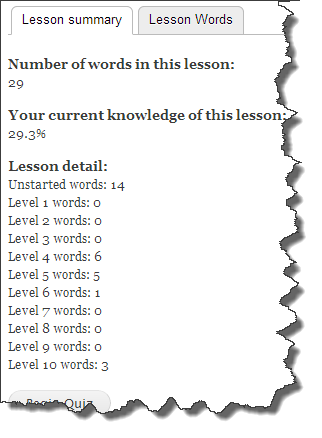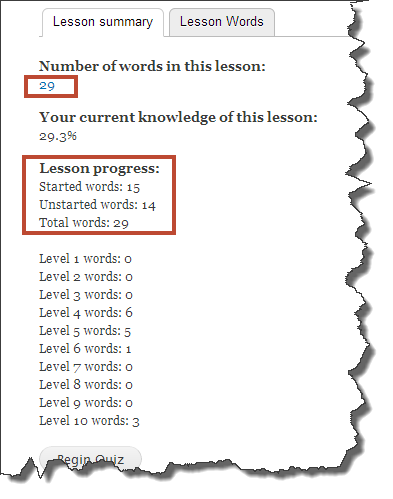I have made a few small usability enhancements to the lesson pages which I'll go through here. Each one of them is very small, almost unnoticable, but for Lingopolo to be really easy-to-use, it is the attention to such details which can make all the difference between a user saying "I really like using Lingopolo.com..." and them thinking the opposite because it becomes difficult to use. The user usually won't know what makes a site difficult or easy to use; the answer is usually the cumulative effect of all the design decisions small and large.
Below are two images, on the left, how the lesson pages were before, on the right the way the lesson pages appear now.


The first change is that the number of words (e.g. 29 in the example below) links directly to the "Lesson Words" tab page. Now, in the past the user could of course click on the "Lesson Words" tabpage. But there are a few advantages to also having it as a link on the number:
- the user doesn't have to know about the "Lesson Words" tab when reading the page, and when they click on the link it helps them to discover it
- when any user is looking at the page, their eye is likely to be reading "Number of words in this lesson: 29" and so at that point in the process their eye is on the number 29, so that is where they most logically and most conveniently expect to find a route to the actual words behind this number 29
The second is the change of the subtitle from "Lesson detail" to be "Lesson progress". The word "detail" is quite general and implies of course detail about the lesson, but the question is there, what detail? In fact what is there is detail about the progress of the lesson, hence the title "Lesson progress" describes much more accurately what is shown. This is a subtle but important usability enhancement, because now the user is immediately guided to understand that what follows is detail about their progress on the lesson, rather than anything else.
The third change is the addition of two extra lines: a "Started words" line and a "Total words" line. The "Started words" did not exist at all before. Often this did not matter, like when you were just starting a test, if the number of words in the lesson was 29 and the unstarted words was 29. However, when I was using Lingopolo myself to do lesson quizzes I sometimes wanted to know how many words had been started, and it was not immediately obvious. I would either have to add up the number of Level 1 words plus all the Level 2 words plus all the level 3 words etc. (which is probably what a user would do) or, since I know the relation between unstarted words and the number of words in the lesson, I could take the number of words in the lesson and subtract the number of unstarted words (e.g. 29 - 14). Obvious solution: display the number of started words! When that is done, I think it's also nice to repeat the total words. It's true that this is already shown on the page under "Number of words in this lesson", but firstly why make the eye shift around for this information when it can be easily repeated here, and secondly it makes it easier for the user to understand what the concept of "started" and "unstarted" words is when they see graphically that started words + unstarted words = total words.
Each of these changes is tiny. Maybe you think they are really not that important. In themselves they are not, but together with hundreds of other attentions to detail in the site, I hope that you find Lingopolo really easy to use, even if you don't know why. And if you spot something which you think could be done better, I would love to hear from you.
